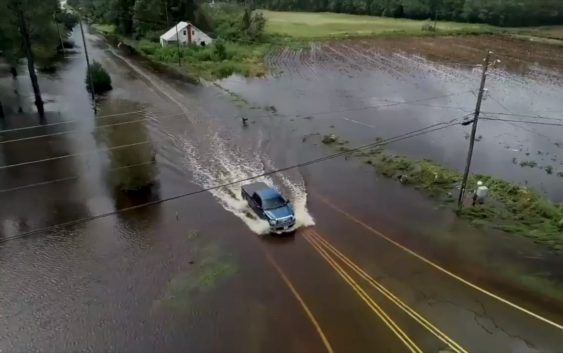- Seven months after Hurricane Helene, Chimney Rock rebuilds with resilience
- Wildfire in New Jersey Pine Barrens expected to grow before it’s contained, officials say
- Storm damage forces recovery efforts in Lancaster, Chester counties
- Evacuation orders lifted as fast-moving New Jersey wildfire burns
- Heartbreak for NC resident as wildfire reduces lifetime home to ashes
It’s been a week since Florence hit. Rivers are rising, roads are still flooded.

A week after Hurricane Florence arrived on shore, large swaths of North Carolina remain underwater.
Florence is responsible for the deaths of 32 people in North Carolina. The storm also caused flooding that’s submerged roads, homes and businesses, killed thousands of livestock animals and is possibly carrying waste into the state’s rivers.
The storm “has deeply wounded our state, wounds that will not heal soon. So many people are still hurting,” Gov. Roy Cooper said in a press conference Saturday morning.
“Many storm victims still need a place to call home for weeks or months,” he added.
As of Saturday morning, here’s a look at the situation.
Flooding: The Cape Fear, Lumber, Neuse and Trent rivers are overflowing and continue to cause major flooding across nine counties in southeastern North Carolina, officials said.
People impacted: 32 North Carolinians have died as a result of Florence and 2,800 are living in shelters — down from a peak of about 20,000 earlier this week, Cooper said. There have been nearly 5,000 water rescues, he said, adding that FEMA on Monday is launching a transitional housing assistance program in nine NC counties.
Recovery: About 69,000 people have registered for federal financial assistance through FEMA, Cooper said. And FEMA has already approved more than $12 million in relief for North Carolinians affected by Florence, said Albie Lewis, the local FEMA directing officer. Authorities are also opening 10 mass feeding kitchens, said Mike Sprayberry, director of N.C. Emergency Management.
Power outages: About 2,900 outages remain, down from about 8,000 Friday and 632,500 last Sunday.
Roads: Parts of Interstates 40 and 95 remain underwater, while more than 500 roads remain closed statewide. People shouldn’t drive on any of the roads east of I-95 or south of U.S. 70.
The N.C. Department of Transportation is still waiting for flood waters to subside in several areas, DOT leader Jim Trogdon said.
“The road you plan to drive on may not exist anymore,” Cooper said.
Pollution: Duke Energy and state environmental regulators said Friday that flooding could be causing coal ash to spill out from a pond near Wilmington into the Cape River. Flood waters need to lower before authorities can send inspectors to determine the extent of spills, Michael Regan, leader of the state’s environmental agency, said in Saturday’s press conference.
Agriculture: The N.C. Department of Agriculture and Consumer Services earlier this week that Florence killed 3.4 million chickens and turkeys and 5,500 hogs, as the N&O’s John Murawski reported Tuesday.
Virginia Bridges and John Murawski contributed.
This is a developing story.